Antibodies, Cytokines, and ELISAs to investigate the novel Coronavirus
Antibodies, Cytokines, and ELISAs to investigate the novel Coronavirus
COVID19 is a brand new disease and the biomedical community desperately needs more tools to understand it. In this webinar, Dr. William Olds, Scientific Officer, discusses newly developed antibodies, cytokines, and ELISA kits to empower scientists to discover the Achilles’ heel of this disease.
Video Transcription
Hello everybody, and welcome to this webinar. We're just going to give a couple of moments here to allow a couple more attendees to trickle in, and then we'll get to the good stuff here. So, please be patient for a couple more seconds here.
All right. I see a couple more people have logged on here. It's past 10:00, and I'd like to be on time. So, let's get started here. My name is Will Olds. I'm the scientific officer here at Proteintech. I've been in this position for about five years. It's been an exciting ride so far. I'm delighted to talk to you guys about some of our newly developed cytokines, antibodies, and ELISAs to investigate the novel coronavirus. I do want to mention that we do have some handouts available. It should be on your control panel and just talking to you a little bit about Proteintech as well as our overall COVID-19 flyer that has information on what you could use. So let's get started here.
Introduction to Proteintech
All right. Who is Proteintech? Who is this person that's even talking to you? Proteintech has been around since 2002. We have an antibody target range of about 13,000. That represents both rabbit polyclonal and mouse monoclonal antibodies as well as some newer recombinant antibodies. We have 200-plus ELISA kits. We have human cell-expressed cytokines and growth factors. We have directly conjugated antibodies for your staining experiments as well as neutralizing antibodies and some prestained protein markers as well for your Western blots.
The thing that's great about Proteintech is that everything is 100% manufactured and validated in-house. We have all the ISO certifications for your clinical trial and therapeutic needs. We have five sites globally with full product inventory, so you never have to wait. And our products have been cited over 65,000 times in every journal. we can think about as well as having some GMP-grade products available. We love to really support the scientific community, like giving webinars like this, as well as getting mentorship awards, travel grants, and other technical workshops.
This figure right here really kind of represents who we are as a company. Our slogan is from our bench to your bench. And so, unlike a lot of other antibody vendors, we are not resellers. Everything we make, we send directly to you, as you can see from this line, from us to you. What that means for you as a customer is that we're able to really have a lot of quality control over our products, and we're able to provide a stable supply from the people who make the antibody and people giving you the antibody.
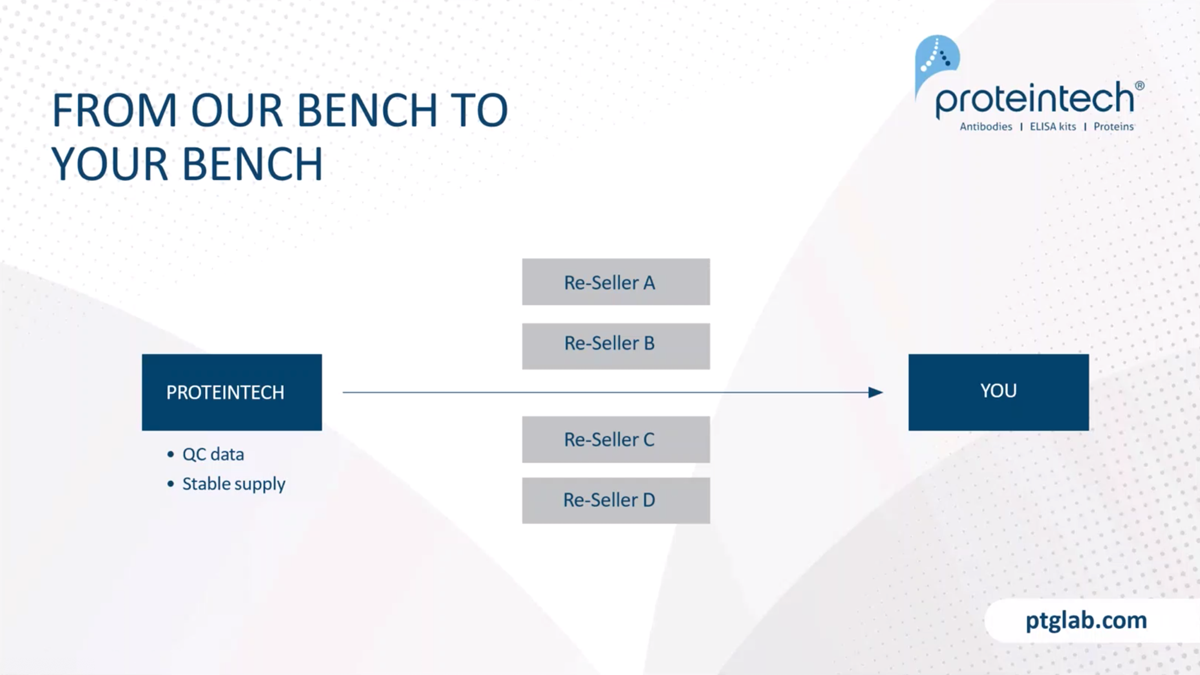
I like to say that validation is our middle name. We have a stringent validation product process. Before everybody was even talking about the pillars of validation, we were actually launching our siRNA knockdown validation initiative in 2015. In 2016, we won CiteAb's award for most exciting antibody validation initiative for this effort. We have the broadest coverage of antibody targets with specificity verified by KD/KO validation, so that's over 2,500 targets at this point, as well as having antibody-specific protocols available. So, you get to see our transcribed lab notebook pages.
Really, it's not about us; it's about you. And so, we're really excited to help people to publish in over 65,000 publications and really to be a growing effort to really accelerate your research and help you find the cures and other exciting biology.
All right. Let's think back to our history here. In terms of diseases that we've studied, we've been looking at cancer since at least 1600 BCE. That's about 3,600 years that we have been looking at cancer and been studying it, trying to figure it out. Since about 400 BCE, we've been trying to conquer influenza, and in 300 BCE, we have formally been studying biology. And then since about 150 CE, we've been studying anatomy, how the different organs are stitched together and help us grow and proliferate.
We've only been studying SARS and MERS since about 2000, and the coronavirus, as you can see all the way on right here, about five months ago. To think about how much we know about cancer, the flu, biology, anatomy, even SARS, we have a lot of catching up to do to really get up to the sophistication that we know about all these other diseases.
Since January, according to PubMed, more than 11,000 papers have been published on the novel coronavirus. However, critical questions still remain. Why are some patients asymptomatic? How long does acquired immunity last? Is antibody-dependent enhancement a possible mechanism during infection? How many organs are infected? And then how many organs are infected, and what is the cause of the reported kidney, heart, and neurological long-term issues?
Our goal today is to empower you with antibodies, ELISAs, and proteins to understand COVID-19.
This figure here represents the relatively little that we know about the coronavirus. As you're probably well aware, everybody's favorite receptor these days, ACE2, binds to the coronavirus as well as with some help of TMPRSS2 to help this enter. This then goes into an endosome, and it's uncoated. There's a lot of types of protein translations as it goes along. It goes to the ER. It eventually gets assembled into the new viral particle and goes out.
All of the stuff that happens here is relatively unknown, and that's what we really want to help you find out with our antibodies. There are a couple of targets I want to highlight here, obviously, ACE2 and TMPRSS2 as well as some really interesting ones that are in kind of this unknown space in the middle here.
Coronavirus-Related Products
All right. SoACE2, as I said, everybody's favorite antibody at this moment. We offer that in a rabbit polyclonal and a mouse monoclonal form. The polyclonal has about five publications as of now. It's been validated by KD/KO validation as well as being useful in a variety of applications, including Western blot, IP IHC, immunofluorescence, and flow cytometry. We also have a mouse monoclonal antibody, which is depicted here on the right in Western blot using PNGase F. You can see how the band slides down quite a bit after adding PNGase F, which shows as the specific for the ACE2 target.
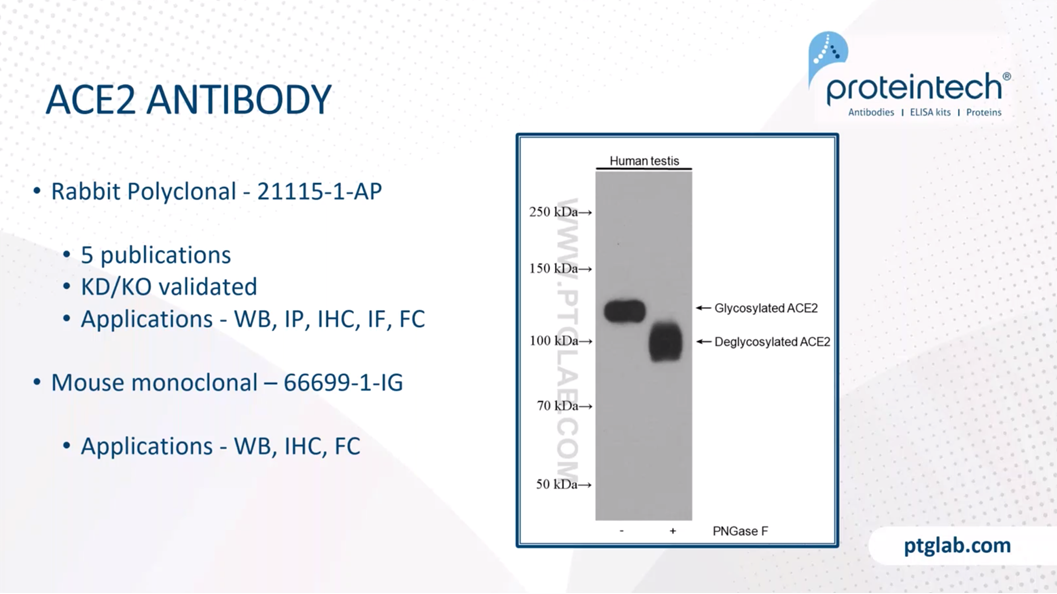
Now, the next target I want to highlight is TMPRSS2. This is a rabbit polyclonal antibody, and it's been validated in both Western blot and IHC. Some examples are here on the right. Western blot is from COLO 320 cells, and then the IHC is from human prostate cancer.
All right. One of the more interesting parts I want to highlight is Cathepsin L. This antibody that we offer is a rabbit polyclonal and KD/KO validated. What's kind of interesting is that this target has already been shown to play a role in SARS and MERS pathogenesis. It may also play a role in SARS-CoV-2 as well. On the right here, we have an siRNA experiment, showing that when you add an siRNA construct against Cathepsin, the band disappears, showing that this is specific.
The next interesting target I want to highlight is MX1. That has got 52 publications. It's got KD/KO validation. This one interferes with general viral protein translation. This target could be implicated within the SARS-CoV-2 and would be an interesting one to check out to see if it has an effect.
Another target I want to highlight here is ISG15. This antibody has been cited 18 times and KD/KO validated. And again, this just has general antiviral activity. Again, this may be something that we could take advantage of in terms of therapeutics or in terms of the pathology of this.
Now you've got a bunch of antibodies, and you start to run into a problem pretty quickly. You have a stain for your nuclear stain with DAPI. You have F-actin. You can stain with that. And then you try to stain for a bunch of other targets, and you run into some issues. So, you have a mouse monoclonal, and that's great. You're able to get a nice secondary to also latch onto this antibody. You get some nice signal. And then we have a rabbit polyclonal towards this protein. You get a nice secondary for that.
However, for this other one, you're only able to find a rabbit polyclonal. And so, you can't just use some of their secondary on there because then the secondary is going to get this guy as well. And so, that becomes an issue when he wants to do more than just a couple of targets and use more than a couple of antibodies on a specific tissue.
And so, to help scientists with this, we have created a line of conjugated antibodies. We call these CoraLites. This is a fluorescent, proprietary dye that we have created. It comes in a couple of different flavors with wavelengths you've heard of before. The first one is CoraLite488, CoraLite594, and lastly, CoraLite647. They're really great for these immunofluorescence studies requiring multiplex co-labeling studies, and you don't need to use any secondary. So, this background here is a great HepG2 cell immunostaining using ATP5A1, cytokeratin, and DAPI, making this beautiful staining over here.
CoraLite Fluorescent Dye-Conjugated Antibodies
What are the CoraLite antibodies, and what is this dye? All of our antibodies have been validated and published before, now conveniently conjugated to multiple colors and are ready to use. We already know the base antibody is very good. And so, we just add a fluorescent dye to it, and now it's perfect and validated and ready for use. CoraLite itself is a proprietary fluorescent dye. It is equivalent to Alexa dyes in performance, in brightness, stability, and size. Currently, we have about 400 targets that have been conjugated with a variety of these CoraLite dyes, and they're growing.
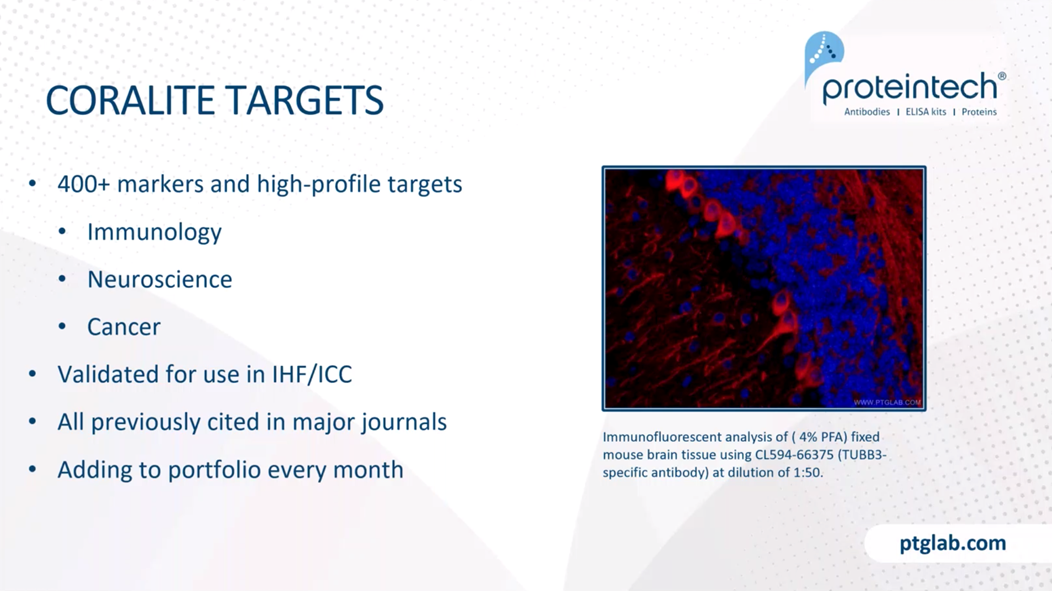
In terms of the targets that we've selected thus far, we've picked ones mostly so far in immunology, neuroscience, and cancer. On the right here, you can see an example of one of our neuroscience targets with a TUBB3 antibody, which is a neural-specific marker, and you can see this beautiful neuron staining here. We have validated these for IHF as well as ICC as well. As I mentioned before, these are all previously cited in major journals, and most have KD/KO validation already, and we're adding to this portfolio every month.
As I mentioned, we started with some published KD/KO antibodies, such as this one over here, the CD206 antibody. We add the CoraLite dye to it, and now we get the magical, beautiful-looking stain that we see here in green with the CD206.
I just want to show some great pictures and usages of the CoraLite product so far. On the left here is an immunofluorescent picture here of HepG2 cells with the ATP5A1 and Cytokeratin 18, which you previously saw as the background, but now it's in the foreground here. On the left here, it's a great staining of a rat brain with GFAP, a glial marker, and MAP2 as well as DAPI in there as well, and creates this beautiful staining that you see here.
When should you use CoraLite antibodies? When will they perform the best? They're really great for multiplex imaging, as I said before. They're also really great for cell markers, organelle labeling, or for highly concentrated proteins.
Here are some examples of the markers here, so some Cytokeratin 18 for the cytoskeleton, and on the right is a GFAP glial marker, as I said before. CoraLite is great for that. These are abundant markers, and they can make some very great images.
They're great for organelles as well. On the left here is staining with DAPI and Lamin B1. Lamin B1 cells, the nuclear membrane, so you can see that kind of hovering around the DAPI staining here. On the right here, we have HepG2 cells stained with COXIV, which is mitochondrial marker.
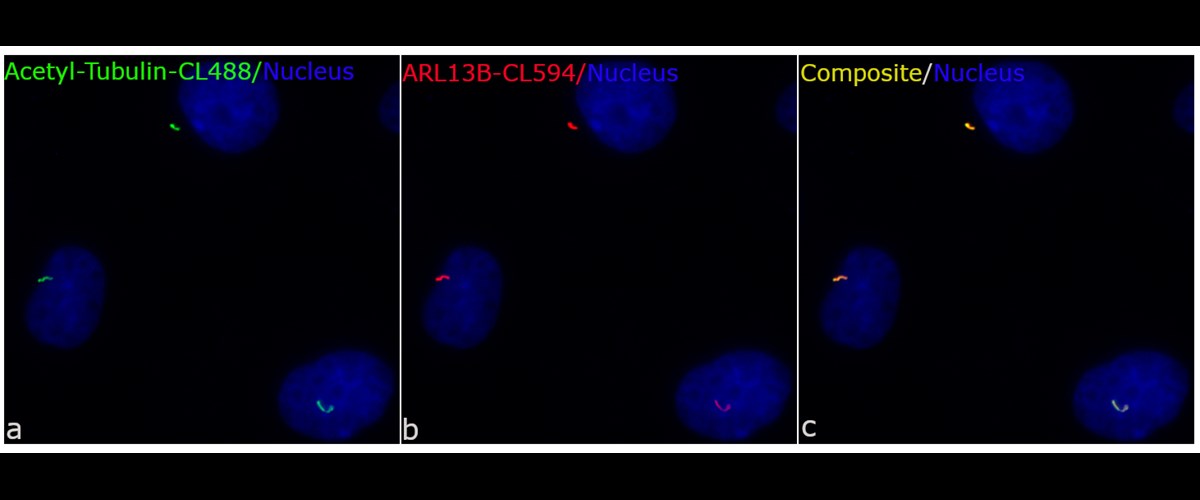
The CoraLite antibodies are really great for concentrated proteins as well. Here in A, B, and C, we have staining with two different markers for the cilia here. One is ARL13B, which is in red, and then there's Acetyl-Tubulin-488. These both mark the same thing, and as you can see here in the green and the red, they overlap completely and make this a really great staining here.
These CoraLite antibodies are really great for direct staining, but it's not perfect. Indirect IHF is best for low-expressed proteins. These CoraLite antibodies can bind to these targets, and fluoresce quite significantly. However, the indirect, you add the secondary on there, it's amplifying the signal significantly. And so, you're able to get a much better signal and then able to amplify the signal at a low-abundance protein.
Okay. Back to our little schematic here. Now we've got a bunch of antibodies looking at different targets. We've got some CoraLites in there as well. But the guy that we really want to track throughout its life cycle here is the SARS-CoV-2 itself.
And so, we've recently entered into a collaboration with Active Motif to provide recombinant coronavirus antibodies towards the spike protein. These are antibodies that have been derived from B cells from recovered COVID-19 patients overseas, and they've been screened for binding affinity towards the S protein. After they'd been screened, they were cloned and expressed in HEK293 cells with a human backbone, and because these are absolutely brand new as of maybe a couple of months ago, there has been a limited characterization so far of these antibodies.
We offer nine clones as of this moment, and they have been tested in several different applications, the Western blot neutralization of the coronavirus, and we offer all nine of these clones for you to test and see and kind of test the limits of what these antibodies can do.
Recently, a few clones have been shown to have neutralization activity. And so, this is a paper that was published and cited. That was in the bioRxivs a couple of weeks ago, showing some neutralization of the pseudovirus infections model.
Some of the advantages of this line is that they have a human backbone, so they can be easily multiplexed in rabbit and mouse antibodies. Some of them have neutralizing abilities for in vitro and potential in vivo studies as well as being useful for assay and testing development. We obviously need a lot more of these serology tests at the moment.
Speaking of serology tests, we do have offer IgAs and IgMs and IgGs for creating these serology tests for expanding the contact tracing, and seems to have immunity towards this virus at the moment.
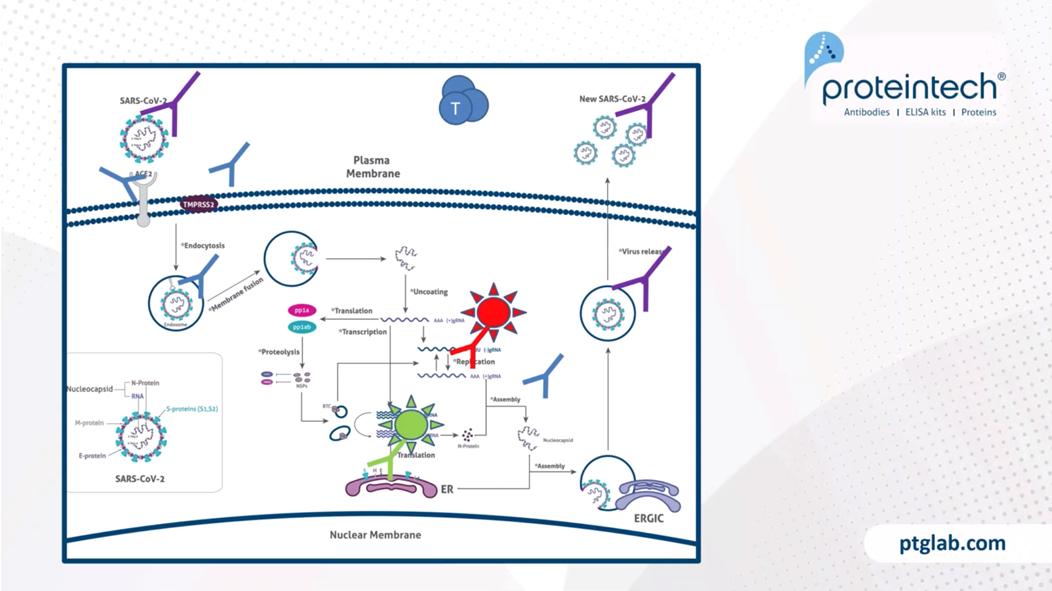
Okay. Now we've got a bunch of antibodies to play with here to really find out who's all playing with the novel coronavirus. There has been some research showing that CAR T-cells may be useful in the fight against the coronavirus.
As you guys are well aware, the CAR T-cell therapy starts with collecting patients' white blood cells, doing some CRISPR trickery in there, expanding the T-cells, and then putting them back into the patient. This part in the middle here, where you're engineering the CAR T-cells, and you're growing them and you're maintaining them, the cells need a lot of cytokines and growth factors in order to live and proliferate and be maintained.
HumanKine® Human Cell-expressed Proteins
And so, we offer a line of human HEK293 cell-expressed cytokines and growth factors for this purpose. What are the advantages of that? Most protein production is done in E. coli. So, following central dogma here of DNA, it goes into RNA, and then it's made into protein. For E. coli, it just hops right off the ribosome. You add the purification tag. And then there's a bunch of endotoxin there as well because it's E. coli. It's a big problem, especially if you wanted to make a human protein.
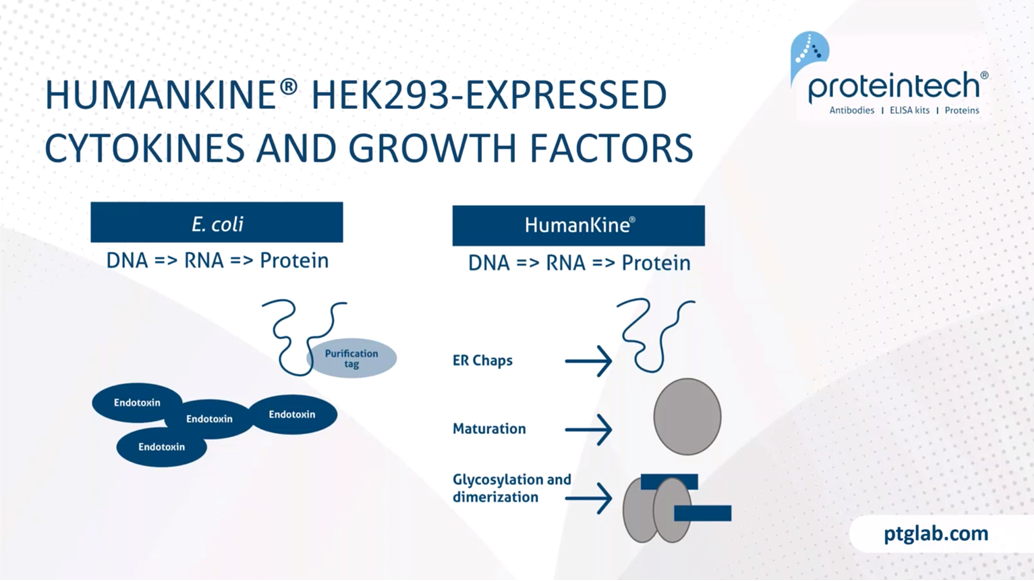
For humans, these proteins generally go to the ER, where there are ER chaperones. They help shape these proteins. There's been several maturation processes that occur, and eventually gets glycosylation, dimerization, and what have you. So, this is very complex. This is a complexity that our HEK293 cell-expressed system has that E. coli just do not have.
We have an ISO 13485-certified GMP facility. These products are incredibly safe because they are animal-component and xenobiotic-free. So, you don't have to worry about any of these endotoxins, any of these other issues that happen with using E. coli in creating proteins. Because they go through all the post-translational modifications and maturation, they have native folding as well as having native glycosylation, resulting in high stability and activity.
One of the products I want to highlight here is our GMP grade Activin A. This is one that is essential for stem cell maintenance and for cell culture maintenance in general. This is a protein that's highly processed. So, if you just look at this gel over here, the Activin A precursor is pretty heavy. It's processed later on into a monomer and then finally into a dimer. As you can see here, comparing this CHO cell, CHO cell-expressed one versus the HumanKine Activin A, you can see that there's a thicker, more significant band for the dimers here, showing that this is the mature active form. Currently, this is the only GMP human cell-expressed Activin A on the market.
We also offer FGF Basic-Thermostable. And so, here is an experiment showing the stability of FGF Basic in xeno-free media without cells, and showing that, over time, the FGF Basic that we make, in red here, lasts for several days, whereas the one that's made from an E. coli expression system, it is practically zero after one day. And so, what this means is that you get a little bit more bang for your buck as well as not having to go in on the weekends to change your cells.
NeutraKine™ Neutralizing Antibodies
All right. Now, something else that's been a bit of a concern for the COVID-19 is the cytokine storm that happens in a lot of the deadly cases. So, we also have some antibodies towards those as well that we call NeutraKine antibodies. We make these using our HumanKine proteins by injecting them into the mice and then selecting for antibodies that come out of this mouse that are able to disrupt the binding of the cytokine to the receptor and causing the cytokine storm.
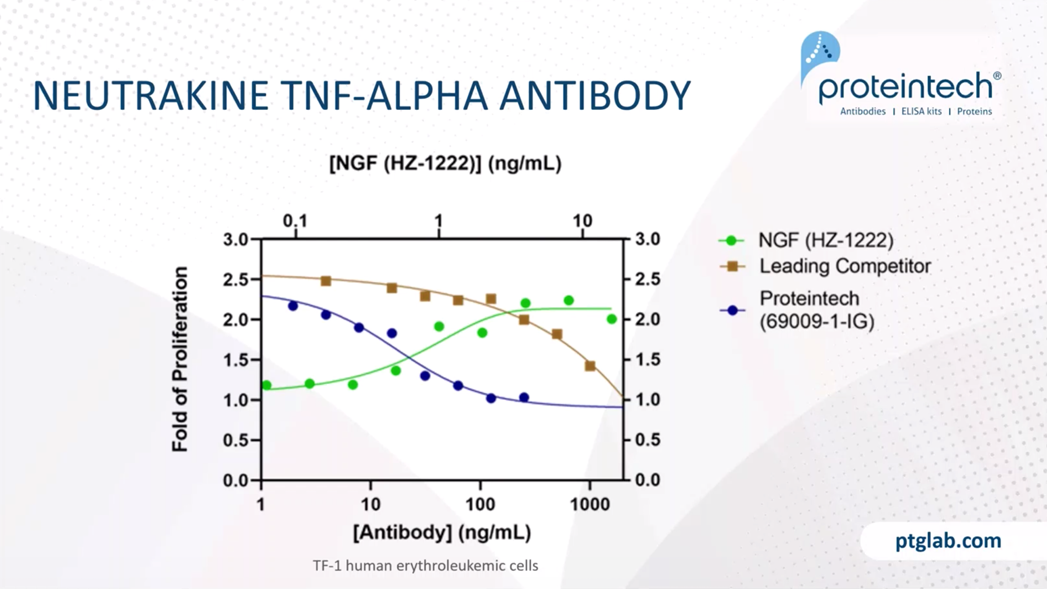
We have about nine of these right now, and they're growing every couple of months here. One of the ones I want to highlight here is our TNF-alpha antibody. This is a neutralization assay here depicted. It's a bit confusing, so let me just walk you through how it works here. Let's start here with this green line. This green line is just adding the protein itself to the plate and seeing what happens to the cells that are under study. In this case, it's TF-1 human cells.
As you can see, the proliferation, it goes up significantly as you add more protein, which is as to be expected. Now, I want you to take a look at the activity here when you start increasing the amount of antibody. Here's the leading competitor. As you add more of this antibody, it decreases the amount of proliferation. However, you notice that this curve is the one using the Proteintech's NeutraKine antibody. The curve is much steeper, and it goes down to very low activity, very low proliferation very quickly. So, this antibody has a much higher affinity, a much higher neutralization activity than this competitor here.
AuthentiKine™ ELISA Kits
Now let's look more into quantifying the products that are within the cytokine storm. We've created a line of ELISA kits that we call AuthentiKine ELISA kits. Like before, like the NeutraKines, these are made using our HumanKine products. So, the HumanKine proteins are injected into the mouse, and then we select two antibodies from the mouse in order to make a sandwich ELISA kit. Below here, I have a little table here just showing our sensitivity in our ELISA kits compared to their competitors and for IFN-gamma and Cystatin C, we have 20X and 10X fold better sensitivity than competitors.
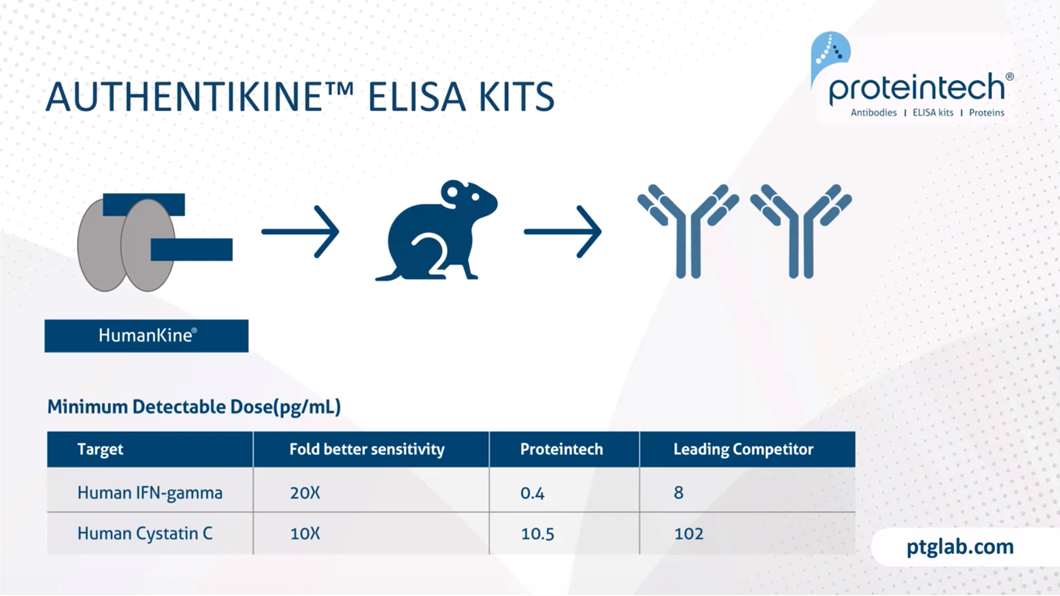
One of the ones I want to highlight is IL-6. Obviously, this is one of the major players in the immune response. And so, this is made using our IL-6 HumanKine cytokine. This is a sandwich ELISA. It's got a great sensitivity of 1.2 picograms per mL as well as having a significant range of 7.8 to 500 picograms per mL.
All right. Now you have antibodies to detect the coronavirus, to look at what's happening with ACE2 and TMPRSS2 as well as investigating other targets, being able to multiplex with the CoraLite antibodies, being able to help expand your CAR T-cells for CAR T-cell therapy as well as trying to neutralize or trying to understand more about the cytokine storm as well here.
I want to thank you for attending this webinar. I am open for any questions. Feel free to email me or ask questions now. So, I'll just keep it open for a couple of moments here.